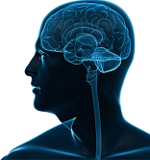Tagged with “diagnostic tools”
August 2, 2018
In our May, 2014 post, we reported on research showing that traumatic brain injury, including mild traumatic brain injury (mTBI), can damage and cause dysfunction in the pituitary gland resulting in deficiencies in key hormones released by the pituitary gland, such as Growth Hormone (GH). As we explained in that post, the anatomy of the pituitary gland makes it particularly susceptible to the sheering injuries seen in TBI. The pituitary gland, which is housed in a bony structure at the base of the skull, controls the function of most other endocrine glands and is therefore sometimes called the “master gland.” Read More
August 17, 2017
The open source journal Brain Science has just published a survey of literature demonstrating that a mild traumatic brain injury (mTBI) , otherwise known as concussion, is a complex pathophysiological process that can have a systemic effect on the body aside from solely impairing cognitive function. According to the article, “dysfunction in the autonomic nervous system (ANS) has been found to be a major factor in the symptomatology in TBI, including in mTBI” and can “induce abnormalities in organ systems throughout the body.” Read More
June 8, 2017
The May 16, 2017 issue of The American Journal of Sports Medicine highlights the significance of subtle changes in vision following concussion in predicting more prolonged recovery. The study found that a diagnosis of “convergence insufficiency” increased the odds of prolonged recovery by 12.3 fold. Read More
February 6, 2017
A topic frequently addressed in this blog is the building body of evidence showing that the minority of patients who have long term, sometimes permanent, symptoms following concussion typically experience those symptoms because of injury to the brain, not to achieve some “secondary gain.” Although scientists do not have a clear understanding about why some people are more vulnerable to these injuries, we know as discussed in prior posts, that certain factors can play a role, such as genetics, prior head injuries and a history of migraines. Two recently published studies contribute to our understanding that real pathology likely underlies most persistent symptoms and that this pathology can be identified with advanced neuroimaging techniques. Read More
January 5, 2015
The weight of scientific evidence demonstrates that “diffusion tensor imaging” is an effective tool for demonstrating damage to the white matter of the brain associated with mild traumatic brain injury.
The damage typically associated with mild traumatic brain injury (mTBI) is in the axons, the microscopic fiber tracts in the white matter of the brain too small to be seen by conventional tools such as MRI and CT. In fact an individual with a perfectly normal MRI and CT could even be in a coma due to a brain injury. Treatment providers have been left to infer injury from clinical symptoms. However, even the most commonly used clinical tools, such as neuropsychological assessment, are generally seen as insensitive to the subtle, but sometimes life altering, effects of mTBIs. Read More
December 4, 2013
In a study published November 18, 2013 in Frontiers in Neurology, researchers from Penn and Baylor report that they have identified a blood biomarker – SNTF – that if found on the day of injury predicts with substantial accuracy both cognitive impairment persisting more than 3 months and the existence of abnormal brain imaging finding in the corpus callosum and uncinate fasciculus of the brain (using diffusion tensor imaging (DTI). Read More
October 24, 2013
The August issue of the Journal of the American Medical Association (JAMA) includes a “Viewpoint” by two leading neuroscientists promoting the use of an “International Knowledge-Based Approach” to traumatic brain injury (TBI).
One of the causes of the failure of clinical trials to successfully treat TBI, the authors contend, is the common classification of TBIs as “mild, moderate or severe.” These classifications do not incorporate newer insights and findings from diagnostic tools such as imaging and biomarkers and therefore do not promote “mechanistic targeting” for clinical trials. The authors support the transition to a more nuanced approach, a precise disease classification model that is based on the precise pathoanatomical and molecular features of the injury. Read More
August 1, 2013
In July, 2013 the Defense Centers of Excellence, serving the United States Department of Defense, issued important new guidelines for neuroimaging following “mild” traumatic brain injury. The guidelines begin with the well-accepted understanding that neuroimaging is not typically included in the diagnosis of mild traumatic brain injury(“mTBI”) because only 10-15% of people who sustain trauma resulting in mTBI will have an acute brain lesion on CT (computed tomography) scans. “The lack of positive imaging findings,” the guidelines emphasize, “does not invalidate a diagnosis of mTBI.”
What is significant about the guidelines is that they recommend imaging in mTBI cases where the victim has “new, persistent or worsening symptoms” 90 days or more following the injury (described as the “chronic stage.”) Read More
June 27, 2013
Concussion, or mild traumatic brain injury (TBI), typically produces no gross pathology, such as hemorrhage or abnormalities, that can be seen on conventional CT scans of the brain. It does cause rapid-onset neurophysiological and neurological dysfunction that in most patients resolves spontaneously over a fairly short period of time. Studies have shown, however, that approximately 15% of individuals with mild TBI develop persistent cognitive dysfunction and other symptoms. Researchers are starting to make progress on proving mild traumatic brain injury using the biomarkers that underlie such symptoms. Read More
